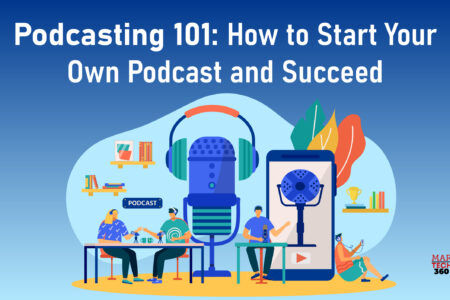Podcasting is a relatively new phenomenon, with the term “podcast” being coined in 2004. Despite its short history, podcasts have made a significant impact on global audiences.
Similar to radio shows, it has distinct advantages that attract a wide audience and content creators.
Podcasts come in various types, and each one is unique. Regardless of how you define podcasting, it’s evident that this format requires further examination and that is exactly what we have broken down in this blog.
What is Podcasting?

Podcasts are an accessible option for content creators to communicate with an audience, in contrast to more conventional content production techniques like TV and radio programs. At present, you don’t even require a broadcasting license to publish podcast content because they are unregulated. Anyone who has access to a microphone, recording software, and a hosting platform subscription can start their own podcast.
Plus, it has no set format, length, or style. Podcasts can cover various subjects, but each episode usually centers around a single topic or story. Some podcasters use scripts, while others rely on improvisation. Getting into the science of it, the culture surrounding podcasting is known as the podosphere, similar to how the blogging culture is called the blogosphere.
These serve various purposes, including entertainment, education, staying informed, and finding humor. They are effective marketing tools that promote businesses, expand reach, and target existing audiences. The number of active podcast listeners in the United States exceeds 100 million and is expected to hit 254.35 million by 2027.
Most importantly, podcasts have the ability to inform, inspire, and engage listeners, providing a flexible medium for sharing content in a way that appeals to those who prefer audio over written articles.
Types of Podcasts
Podcasts, like books and movies, cover a range of topics that cater to different audiences. Although comedy is the most popular genre, true crime, news, and business podcasts also have a significant following.
Podcasts are diverse in terms of their length, tone, and format. They come in various styles and are widely popular.
- Conversational
- Theatrical
- Repurposed
- Hybrid
- Monologue
- Non-fiction Storytelling
Also Read: The Benefits of Marketing Automation: Why It’s a Game-Changer for Your Business
How Does Podcasting Work?
Here are a few of the best podcast platforms:
- Buzzsprout
- Podbean
- Podcast Websites
- Simplecast
- Spreaker
A podcast directory refers to an app that allows users to find, save, and play podcasts. Subscribing to a podcast automatically updates a user’s device with fresh episodes.
Some popular directories are:
- Podbean
- Spotify
- Apple Podcasts
- Blubrry Podcasting
- Stitcher
- TuneIn
Podcasts can be uploaded to Patreon, SoundCloud, and YouTube for streaming, following which the production is quite simple. A podcaster can convert and upload an MP3 file to a hosting platform or service provider. The MP3’s URL is then inserted into an XML document using an enclosure tag in the RSS format.
Podcasts can be registered with content aggregators such as AllTop or Feedly, which include them in their directories. This process is applicable not only to audio files, but also to image, text, and video files.
How to Make Money Podcasting?
Now that we have a fair idea about what podcasting is, let’s jump into the fun part: monetization.
Given below are the top eight ways you can make money podcasting.
1. Donations
If you want to earn money from your podcast, asking your listeners for donations is an easy and straightforward approach. Platforms like Patreon or PayPal enable dedicated and supportive listeners to contribute and support your podcast.
Creating paid membership tiers for your podcast is a profitable option if you have a dedicated fan base. By offering exclusive content, you can monetize your podcast and provide a sense of special access for your listeners. A membership scheme allows podcasters to maintain their independence while earning money without relying on brand partnerships.
2. Ad-Free Membership Options
Consider providing an ad-free option for your paying members if you have already secured a profitable advertising deal. Another option is podcast membership, a subscription where listeners pay a fee for exclusive content and features. Podcast memberships provide both a consistent income stream and foster a sense of community among listeners, benefiting both parties. A membership model is ideal for podcasts with a devoted fan base who consistently follow and engage with your content.
3. Develop Exclusive Content for Subscribers
You have the freedom to be creative and enjoy offering exclusive content to your members. The level of effort required for creating a membership scheme can be tailored to your preferences. You have the flexibility to create more episodes, invite your members to view your live recording sessions, or seek their input for future content. The choice is yours and should be based on your understanding of what your audience is willing to pay for.
4. Create Tiered Memberships
A basic subscription has a small cost for a shout-out on your show, while a premium membership offers the opportunity for listeners to meet you in person or online at live events. Consider joining Apple’s Podcasters Program or Patreon to monetize your podcast through subscriptions and membership plans.
5. Seek Sponsorships or Advertise to Generate Revenue
If you have a large or niche audience, obtaining a sponsorship or advertising agreement should not be challenging.
When selling sponsorships or ads, you offer air time before, during, or after an episode. Mid-roll ads are the most desired and expensive adverts because listeners are less likely to skip them. Post-roll ads are the least effective and cheapest as most listeners either stop listening or move on to the next episode.
Two common types of podcast ads exist.
- The host endorses and discusses the product or service, which can be less disruptive to the episode’s flow.
- Pre-recorded advertisements are provided by the brand or company purchasing the ad slot.
You simply need to include the recording in the specified number of episodes.
Consider joining an advertising network. Podcast advertising networks like Midroll simplify the process by connecting podcast hosts with potential brands and sponsors, eliminating the need for you to search for them yourself.
6. Repurpose and Sell Content
To maximize the value of your insightful podcast, consider transcribing it using Riverside’s automated transcription feature. This allows you to repurpose your episodes effectively. Once you have a transcription of your podcast, edit it into article format and pitch it to relevant publications in your niche.
7. Syndicate Your Show On YouTube
Syndicating your podcast to YouTube involves repurposing it as a video and publishing it on the platform. If you’re unable to record a video, you can still publish the audio of your podcast with the cover art as the video image. You can even use the YouTube Partner Program for podcast monetization.
The YouTube Partner Program allows you to monetize your podcasts, but you need to meet specific eligibility requirements, including a minimum number of subscribers and viewers. Sharing your podcast on YouTube helps you reach a larger audience, including those who don’t typically use podcast platforms.
Here’s a condensed guide on earning money from podcasting through YouTube.
- You’ll receive a share of the ad revenue for any ads shown with or during your content
- Channel Membership allows subscribers to pay a monthly fee for exclusive content and additional benefits
- YouTube offers the opportunity to sell branded merchandise on your channel, providing an additional income stream
- YouTube Premium revenue is earned when a subscriber watches your content, and you receive a share of their subscription fee
8. Sell Merchandise
Branded merch has widespread appeal. If you have a recognizable logo or podcast artwork, you can create a range of items like t-shirts and coffee mugs. The beauty of branded podcast merch is its dual functionality. Firstly, it generates extra income through sales, and secondly, it serves as a highly effective free marketing tool. Whenever a listener wears a branded t-shirt, they passively promote the podcast.
Who are the Top Podcasters?
According to Forbes, the top podcasters in the podcasting space are:
- Joe Rogan, host of The Joe Rogan Experience, earns $30 million annually and has a monthly download count of 190 million downloads.
- Karen Kilgariff and Georgie Hardstark, hosts of My Favorite Murder, have an impressive 35 million monthly downloads and earn $15 million annually.
- Dave Ramsey, the host of The Dave Ramsey Show, has a massive audience of 13 million listeners each week and earns a staggering $10 million a year.
Final Words
Podcasting offers a unique opportunity to establish a personal connection with your audience. Unlike written content, podcasts create an intimate atmosphere that helps in building your brand. However, it’s important to ensure that your target market is interested in consuming podcast content before embarking on creating one. Conducting a survey can be an effective way to gauge the level of interest from your audience.
If you’re eager to start your own podcast, there are several podcasting software options available like Mailchimp and Buzzsprout that can assist you in promoting it. So why wait? Grab some podcasting equipment and you are good to go!

